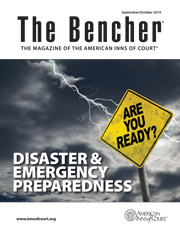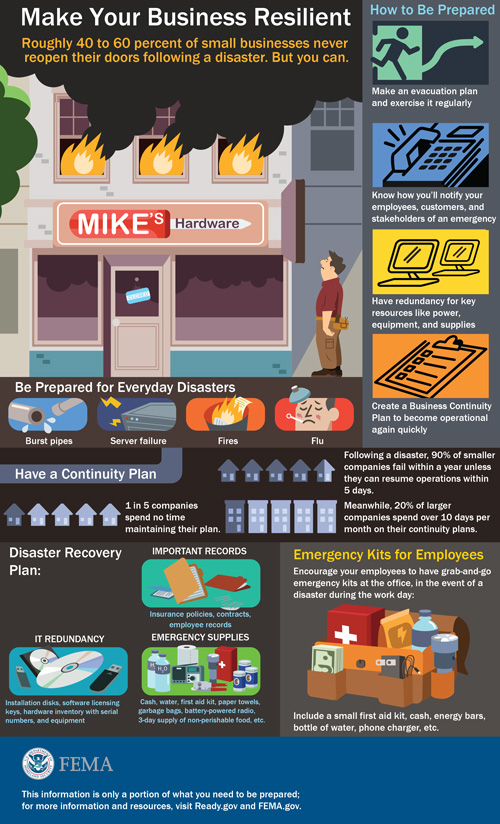Disasters and Emergency Preparedness: Is Your Legal Practice Ready?
The Bencher—September/October 2019
By Natalie Enclade, PhD
 The devastating impact of recent hurricanes and wildfires underscores the importance of preparing to safeguard our livelihoods and way of life. Forty percent of businesses never reopen after a disaster, plus another 25 percent reopen but fail within one year, according to the Federal Emergency Management Agency (FEMA).
The devastating impact of recent hurricanes and wildfires underscores the importance of preparing to safeguard our livelihoods and way of life. Forty percent of businesses never reopen after a disaster, plus another 25 percent reopen but fail within one year, according to the Federal Emergency Management Agency (FEMA).
It is clear that actions taken before an emergency or disaster are a big contributing factor in successful recovery. That includes common activities such as holding fire drills and developing an emergency telephone tree. It also includes a regular and honest review of personal financial health. According to a recent study by the Federal Reserve, 40 percent of Americans do not have enough money to cover a $400 emergency. 2018 FEMA research found 30 percent of individuals do not have any money set aside for an emergency. Having a cash reserve can expedite the road to recovery. Business owners, regardless of profession, should be considering the ramifications of not having a preparedness plan or having liquid assets ready.
Business leaders face a lot of unpredictability every day, and those issues quickly compound in the event of disasters and emergencies. However, planning ahead for the unexpected mitigates these challenges and provides a myriad of benefits. By assessing the amount of potential damage, developing a plan, and taking key actions to sustain business operations post-disaster, the prepared lawyer will have peace of mind. Planning ahead will also limit property damage and place legal professionals in a better starting place to effectively navigate the recovery process. Through simple steps, business owners can worry less and have more control over the hazards and threats that might affect their clients, staff, and community.
 The first step for any legal professional is to identify risks. Most of us know if we live in a community at risk for hurricanes and earthquakes. But what about wildfires and floods? One inch of flood damage in your home can cost up to $25,000, according to FEMA. Can you or your employees absorb that kind of unexpected expense? Insurance can help, but 70 percent of disaster losses are not insured and therefore not reimbursed, according to Swiss Re, the second largest reinsurer in the world. Every business owner should review their insurance coverage every year and encourage employees to do the same.
The first step for any legal professional is to identify risks. Most of us know if we live in a community at risk for hurricanes and earthquakes. But what about wildfires and floods? One inch of flood damage in your home can cost up to $25,000, according to FEMA. Can you or your employees absorb that kind of unexpected expense? Insurance can help, but 70 percent of disaster losses are not insured and therefore not reimbursed, according to Swiss Re, the second largest reinsurer in the world. Every business owner should review their insurance coverage every year and encourage employees to do the same.
Legal professionals should also think about developing a business continuity plan. On the most basic level, this means working with your teams to identify potential hazards that can interrupt business operations and then talking through how each member of the team would respond.
An excellent resource on this is the UPS and U.S. Chamber of Commerce Foundation’s “Resilience in a Box” (www.uschamberfoundation.org/resilience-box), a checklist of key business preparedness actions that culminates in providing a rating on your resilience. This is a good place to start before building a plan. The American Red Cross also has a fantastic tool in the Ready Rating program (www.readyrating.org), which helps businesses evaluate and improve their ability to withstand disaster, maintain operations, and protect lives and property. Another resource is the Florida Bar webinar “Preparing Your Law Firm for Hurricanes and Other Natural Disasters (www.legalfuel.com/preparing-your-law-firm-for-hurricanes-and-other-natural-disasters).
Assembling a team to discuss roles and responsibilities for your business continuity plan can be done regularly, along with providing general preparedness messaging to staff and clients. You should encourage your team to take steps in the office and at home. Business owners should train employees to assist in these emergencies with programs such as “You Are the Help Until Help Arrives,” which teaches five simple actions that may save a life:
- Call 911.
- Stay safe.
- Stop the bleeding.
- Position the injured.
- Provide comfort.
 FEMA’s Emergency Financial First Aid Kit, which was developed in partnership with Operation HOPE, is a useful tool for business owners to organize critical documents. Sharing this tool with employees is also a great way to encourage employees to be financially prepared. Safeguarding important documents will allow easy access to information in a centralized location following a disaster, particularly helpful when individuals apply for disaster relief.
FEMA’s Emergency Financial First Aid Kit, which was developed in partnership with Operation HOPE, is a useful tool for business owners to organize critical documents. Sharing this tool with employees is also a great way to encourage employees to be financially prepared. Safeguarding important documents will allow easy access to information in a centralized location following a disaster, particularly helpful when individuals apply for disaster relief.
Business owners should also consider this critical step, as having documents in place can simplify the process when applying for low-interest loans offered by the Small Business Administration. Saving for a rainy day can also mitigate risks. While there is no one-size-fits-all equation for everyone, setting aside $400 in an emergency fund can be a good starting point. Establishing a cash-in-hand reserve with a variety of different cash amounts provides quick, important liquid assets during response and recovery, as ATMs and e-commerce banking apps may be inaccessible due to power outages.
Finally, understanding your insurance coverage is imperative. Most homeowners and renters insurance policies do not cover flood insurance. Flood damage is a major hazard, and, as noted earlier, one inch of flooding can be extremely costly.
By having a business continuity plan and promoting preparedness actions, your legal practice is heading in the right direction. You can be ready to face disasters when and where they happen. Once you have taken these steps within your own business, FEMA needs your help to prepare others in your community. Consider hosting a Ready Business (www.ready.gov/business) workshop and inviting the businesses you interact with most. Ready Business discusses topics such as business impact analysis, continuity planning and recovery strategies, and employee assistance and support. Preparedness is a whole community effort, and working together through partnerships can benefit everyone who experiences disruptions following a crisis.
Prepare your legal practice and inspire others to do the same. Take these simple steps toward disaster resilience today. Together, we can build a culture of preparedness in America.
Natalie Enclade, PhD, is the director of individual and community preparedness for the Federal Emergency Management Agency.